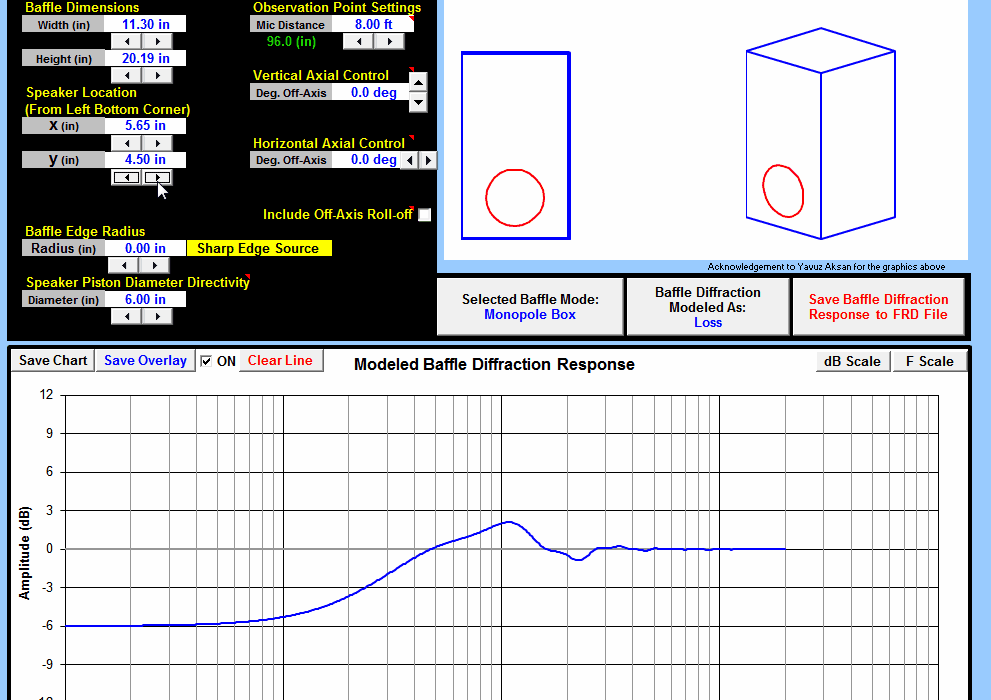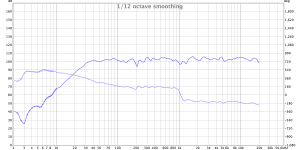If they are desinged to be soffit mounted then that will definitely be changing the balance (if out in the room). Your bass will be up to 6db below what it would be if soffit mounted. The crossovers won't have any baffle step compensation built in. You may also have a midrange hump and dip that wouldn't be there if soffit mmounted.
Tony.
Tony.
Last edited:
I have UREI 813C here in our living room. This is the REW measurement after EQ applied. Bass and top has to be boosted considerable amount. (6 dB or more). My crossover is all recapped with film caps (not too fancy ones). I strongly recommend to do it, those old electrolytic sound horrid compared to replaced films. I'm sure you will hear difference, and probably you'll see a little better FR.
Good luck, I like those UREIs. JBL meets Altec sound. 🙂
Good luck, I like those UREIs. JBL meets Altec sound. 🙂
Attachments
If they are desinged to be soffit mounted then that will definitely be changing the balance (if out in the room). Your bass will be up to 6db below what it would be if soffit mounted. The crossovers won't have any baffle step compensation built in. You may also have a midrange hump and dip that wouldn't be there if soffit mmounted.
Can you please elaborate on why the soffit would affect the midrange? I thought it was only the bass.
Thanks for the baffle compensation concept. I did research on it.
Tony.
I have UREI 813C here in our living room. This is the REW measurement after EQ applied. Bass and top has to be boosted considerable amount. (6 dB or more). My crossover is all recapped with film caps (not too fancy ones). I strongly recommend to do it, those old electrolytic sound horrid compared to replaced films. I'm sure you will hear difference, and probably you'll see a little better FR.
Good luck, I like those UREIs. JBL meets Altec sound. 🙂
Great input. Could you elaborate on how you placed them in your room?
They're just sitting on the floor, no soffit. 5 feet from back wall. Bass is definitely too quiet without EQ. They are designed for infinite baffle as wintermute explained and they are also supposed to be used with house EQ anyway when they were used in the studios. Don't hesitate to use EQ. 🙂
Never got to actually try it, but I would be curious as to how the UREI 813s would fare when tri-amped with a L-R crossover.
Hi barboroja, the midrange can be affected because baffle step is not just a gentle reduction by six db. It depends on the baffle geometry but it can also result in aditional peaks and dips in the response.
The picture below is a baffle step model animation showing how the baffle step changes depending on the position of the driver. On an infinite baffle it would be effectively a flat line (the actual drives response notwithstanding) .

Tony.
The picture below is a baffle step model animation showing how the baffle step changes depending on the position of the driver. On an infinite baffle it would be effectively a flat line (the actual drives response notwithstanding) .
Tony.
813 manual says:
"Electronic equalization can be used to compensate for loudspeaker placement in a room to some extent. Large amounts of boost (i.e., more than 6 db) at frequencies below 80 Hz should not be used, so that the displacement limits of the system are not exceeded and distortion or damage are avoided when the system is operated at high power levels......Smoothest low frequency response will be achieved if the system is mounted so that the front panel is flush with the wall surface and is away from adjacent wall, ceiling, or floor boundaries."
So they are pretty much telling you to soffit-mount them and apply moderate EQ. These are bass-reflex cabinets, eh?
"Electronic equalization can be used to compensate for loudspeaker placement in a room to some extent. Large amounts of boost (i.e., more than 6 db) at frequencies below 80 Hz should not be used, so that the displacement limits of the system are not exceeded and distortion or damage are avoided when the system is operated at high power levels......Smoothest low frequency response will be achieved if the system is mounted so that the front panel is flush with the wall surface and is away from adjacent wall, ceiling, or floor boundaries."
So they are pretty much telling you to soffit-mount them and apply moderate EQ. These are bass-reflex cabinets, eh?
EQ is fine, especially if you EQ the right things. I would like to add that soffit mount will be different to in the room positioning even after you EQ as much as you like, as each has a different acoustic nature.
Pi steradians is quarter space, as in corner mounted. Maybe they meant 4pi steradians?The plots in the manual do cover free space mount, which I suppose is just not soffit (they call in PI STERADIAN)
What exactly would that do?
FIR processing allows the user to adjust the frequency response and phase response independently.
ie, where a conventional (IIR) crossover would introduce phase shifts, an FIR filter can be implemented without those phase shifts.
If you do it right, the system will be impulse-perfect, reproduce square waves, etc.
My current HiFi system uses some FIR processing at the (computer) source, programmed to undo the phase shifts of the passive crossover.
It's neat stuff.
Chris
PS - I did a write-up here: FIR Processing | grimshaw-audio
Thanks for the info! Isn't that what UREI was originally attempting to do with its "Time Align" crossover? Is there a way to do FIR with analog components?
Never got to actually try it, but I would be curious as to how the UREI 813s would fare when tri-amped with a L-R crossover.
That would be a sacrilege ! Unless you correct for the group-delay distortion before the crossover.
Regards
Charles
Never got to actually try it, but I would be curious as to how the UREI 813s would fare when tri-amped with a L-R crossover.
I always wanted to try this, but I have not done yet.
813C was probably considered to be one of the most accurate monitor at its time, but the standard has changed. My stereo pair is still very well matched even after 40 years, but I consider 813C more like a classic speaker like Tannoy, Altec, JBL, and I feel that original analog crossover plus EQ is probably just good enough. Not many people wants to drive Altec 604 with multiple amp with FIR, and I have an impression that UREI is still 604 variant.
Actually, I swapped the woofer to vintage Jensen alnico, and I like it better than original JBL woofer. More classic / warmer tone. I just went to different direction. I believe Altec woofer should work very well with UREI, too. 🙂
I have enough amps to do it, so I'll try, and let you guys know how it is.
Well, perhaps standards change; but not always. In 1958 Gibson introduced the ES-335 model semi-hollow body guitar. It is still the finest electric guitar ever made.
Yep. When I got my pair, I thought they suck, but they are still happily sitting in our room, and I can't find any reason that I replace them despite how they look. I saw white painted ones on Lansing forum, and they look good, though.
Could it be the soffit mounting? GD seems to be sensitive in the lower/middle region.one of the most accurate monitor at its time,
Maybe better to try soffit before multi amp for accuracy. Anyway, my living room is far from ideal studio acoustic condition. It's nothing but a typical domestic room while it is large, so I honestly think soffit is overkill for my situation, unfortunately...
Well, I think it's better to explain my situation a little. I have 2 audio rooms, one is our family's living room for casual listening/home theatre, and the other is acoustically controlled music studio built in garage for critical listening.
I got UREI from a closing private studio in NY because I thought they can be used in my studio, but I was not very happy with them for accurate monitoring, so I just moved them to our living room. I thought it would be temporary, but they ended up sitting there for many years and making me smile every time I play music. That's why I have not really challenged to make them more accurate.
I got UREI from a closing private studio in NY because I thought they can be used in my studio, but I was not very happy with them for accurate monitoring, so I just moved them to our living room. I thought it would be temporary, but they ended up sitting there for many years and making me smile every time I play music. That's why I have not really challenged to make them more accurate.
- Home
- Loudspeakers
- Multi-Way
- Crossover REW Measurement for Urei 813C
